|
April 28, 2016
April 28 -- Day of Mourning
for Workers Killed or Injured on the Job
Our Security Lies in the Fight
for the Rights of All!
PDF
April 28 -- Day of Mourning for Workers Killed or Injured on the Job
• Our Security Lies in the Fight for the Rights
of All!
• Brutal Statistics
• Recent Tragic Deaths in the Workplace
• Workers Speak Out to Defend their Rights
April 28 -- Day of Mourning for Workers
Killed or Injured on the Job
Our Security Lies in the Fight for the Rights of All!
April 28 marks the 32nd annual Day of Mourning for
Workers Killed or Injured on the Job. Workers across Canada as well as
around the world are holding ceremonies, meetings and
moments of silence to mourn the dead and fight for the living.
 On April 28, workers boldly
declare that all workers must be protected according to the highest
standards possible in all conditions and circumstances. They reject the
ideological and
institutional schemes being put forward to deny their demand for safe
and healthy working conditions for all as a matter of right. On April 28, workers boldly
declare that all workers must be protected according to the highest
standards possible in all conditions and circumstances. They reject the
ideological and
institutional schemes being put forward to deny their demand for safe
and healthy working conditions for all as a matter of right.
These ideological and institutional schemes are well
known to workers in all sectors. The monopolies and their spokespersons
claim that workers' health and
safety is a "cost of production" that must be reduced or
eliminated because it is an obstacle to making the monopolies
competitive on global markets. They claim that when the profits of the
monopolies are not at the level demanded by their
private owners or the monopolies go into bankruptcy protection there is
no place for workers' health and safety. This institutional and
ideological offensive suggests that the claims of
injured workers for compensation threaten the sustainability of the
compensation regime and must be suppressed, and that injuries and
deaths on the job are the result of "behaviour
problems" on the part of the workers themselves.
In the face of this, the workers are fighting day in
and day out to break down this wall and ensure that their needs and
rights prevail and all workers are defended. Workers denounce
the failure to provide redress for losses they and their families
suffer as a result of deaths and injuries on the job or which are
job-related.
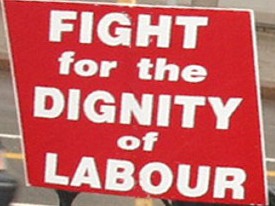 The aim of this fight is to
turn things around and bring about a change in the lives of workers,
their families, communities and the country based on solving problems
posed by
production and how human beings relate to one another to give people
control over their lives. This is how workers' health and safety can be
defended and guaranteed. The feeling of
powerlessness that is imposed on the workers by the arrogant refusal of
the monopolies, governments and agencies to be held to account must be
ended once and for all. The aim of this fight is to
turn things around and bring about a change in the lives of workers,
their families, communities and the country based on solving problems
posed by
production and how human beings relate to one another to give people
control over their lives. This is how workers' health and safety can be
defended and guaranteed. The feeling of
powerlessness that is imposed on the workers by the arrogant refusal of
the monopolies, governments and agencies to be held to account must be
ended once and for all.
The fact that the anti-social offensive being imposed
at all levels is targeting for destruction the health and safety
arrangements of the post-war social contract shows the need for the
workers to build their defence organizations and join together to
defend their rights and chart a new direction.
By joining together in a powerful political movement
that reflects their independent aims and pro-social outlook, the
workers can give a resounding No to the anti-social
offensive and advance a pro-social alternative. They can restrict the
ability of the monopolies to put workers' lives at risk with impunity.
They can achieve the highest standards of health
and safety that society can provide.
That is the fight to which the workers dedicate
themselves on April 28. That is how they commemorate those who have
died on the job and how they fight for the living.
Our Security Lies in Our Fight for the
Rights of All!
Mourn for the
Dead! Fight for the Living!

Brutal Statistics
Canada
The most recent statistics from the Association of
Workers' Compensation Boards of Canada (AWCBC) say that in 2014, 919
workplace deaths were recorded in Canada -- more than 2.5 deaths every
single day. Among the 919 dead were 13 young workers aged fifteen to
nineteen years, and another 25 workers aged twenty to twenty-four years.
On top of these fatalities there were 239,643 claims
accepted for lost time due to a work-related injury or disease,
including 7,998 from young workers aged fifteen to nineteen. These
statistics only include what is reported and accepted by the
compensation boards, meaning the true situation is even more dire.
These numbers also fail to capture how many people are
directly affected by workplace tragedies. The death of a worker impacts
the loved ones, families, friends and co-workers they
leave behind, changing all of their lives forever.
A press release from the United Steelworkers adds that
the number of Canadian workers who die annually through occupational
injuries or diseases "doesn't reflect the fact that for
every worker who dies, on average 30 workers suffer permanent physical
or mental impairments, often lose their employment and many times are
pushed to the margins of society."
"Fewer than half of all Canadians with disabilities are
employed, compared to 80 per cent of the general population, and those
on a social security program receive between 22-30 per
cent of the average net income for all employed Canadians" the United
Steelworkers say.
Internationally
According to the International Labour Organization
(ILO), every year 2.3 million deaths take place worldwide due to
occupational injuries (300,000 deaths) and work-related diseases
(2,000,000 deaths). This means 6,300 workers die each day of
work-related injuries and diseases. According to the ILO, the biggest
killers are work-related cancer (32 per cent);
work-related circulatory and cardiovascular diseases and stroke (23 per
cent); communicable diseases (17 per cent); and occupational accidents
(18 per cent).
Neo-liberal free trade agreements are major factors in
the continued deterioration of living and working conditions in all
countries including health and safety at work. These
agreements concentrate decision-making power on a supranational basis
in the hands of the global monopolies who consider health and safety
regulations as impediments to their drive for
profit and domination. Deaths and injuries take a particularly heavy
toll on workers in the countries of Asia, Africa, Latin America and the
Caribbean due to their super-exploitation by the
monopolies.
The International Trade Union Confederation recently
reported that global monopolies such as Samsung, Apple, Wal-mart and
others directly employ barely 6 per cent of the workers
who create the value of their global empires. The other 94 per cent
work for smaller companies who subcontract to these monopolies, and
face even worse
conditions, without any support when it comes to
health and safety.
This phenomenon is also apparent in countries like
Canada where the working class has been divided into arbitrary
categories such as "independent contractor," "temporary foreign
worker" and "undocumented worker" in order to impose increasingly bad
conditions on the working class as a whole. This increasingly casts a
veil of silence over the truth when workers in
these "categories" injured or fall ill on the job.

Recent Tragic Deaths in the Workplace
Toronto Airport Worker Ian Henry Pervez
A worker at Toronto Pearson Airport, 24-year old Ian
Henry Pervez, was tragically killed on April 22 when the baggage cart
he was driving rolled over and he was flung from the
vehicle. An Air Canada employee, Pervez had been working at the airport
for nine months.
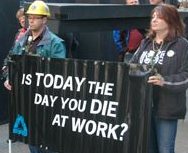 The Toronto Airport
Workers' Council reported that the past 12 months "have been hard on
our airport community with some very high profile injuries and now
horrific deaths."
Another worker died in March of a medical condition while working on
the ramp, the Council reported. An 18-year-old ramp worker was
critically injured in September, 2015 in a collision
between a baggage vehicle and another vehicle. The Toronto Airport
Workers' Council reported that the past 12 months "have been hard on
our airport community with some very high profile injuries and now
horrific deaths."
Another worker died in March of a medical condition while working on
the ramp, the Council reported. An 18-year-old ramp worker was
critically injured in September, 2015 in a collision
between a baggage vehicle and another vehicle.
In statements to media at the time Airport Workers'
Council spokesperson Sean Smith explained problems with the health and
safety policy at the airport:
"The [Greater Toronto Airport Authority] develops
policies and procedures, communicates them to management, all these
dozens of employers, and then counts on them to
communicate it to us, the workers," Smith said. "So they only meet on
these issues with management and then depend on management through
their respective health and safety committees
to do the procedures. Well, here's where problems come in.
"Let's say a company doesn't have a proper health and
safety culture, doesn't have proper communications -- and I'll be
honest, that's a big problem at Pearson Airport, because a lot
of these companies are fly-by-night contract ground handlers that just
have minimum-wage workers," he said. "With a revolving door, there are
new people coming in all the time. So if the
chain breaks down, then there are people working at the airport under
different sets of procedures."
The Airport Workers' Council is holding special Day of
Mourning ceremonies on April 28 to mourn Ian's death and invites
airport workers and their allies to take part. At 10:50 am
airport workers will assemble at two points: Ramp side at Terminal 1,
Gate 101 in the Ozone followed by a march; and Terminal side at the
Inukshuk, Terminal 1 Departures level which
will feature speakers and a prayer from a Chaplain from the Airport
Interfaith Chapel. At 11:00 pm another ceremony will be held at T1 Gate
101 for evening ramp side workers with a
march and moment of silence.
Ottawa Construction Worker Olivier Bruneau
On the morning of March 23, 25-year-old construction
worker Olivier Bruneau was critically injured by falling ice while
working in a 31-metre-deep condominium construction pit on
Preston Street in Ottawa and later died en route to hospital. Bruneau
was an apprentice carpenter and member of Carpenters Union Local 93
from Gatineau, Quebec.
He was employed by Bellai Brothers Construction Ltd.
which is contracted by real estate developer Claridge Homes for work on
the condominium which is advertised as being the
tallest building in Ottawa when complete.
It subsequently came to light that Bruneau and other
workers had complained to management repeatedly that the huge chunks of
ice which had amassed on the sides of the pit were a
serious danger with the rising temperatures and melting. One worker
told media that he had raised the issue less than 24 hours before the
tragedy.
On February 5 a worker had been hit by falling ice at
the same site but was not critically injured. Media report that the
Ontario Ministry of Labour investigated the February incident
but no measures were taken to prevent a similar incident or worse.
Inspectors from the City of Ottawa had visited the site six times but
issued no fines or orders under the Ontario
Building
Code
Act. Photographs from Ottawa Fire Services of the rescue
operation show enormous masses of ice lining the inner walls of the pit.
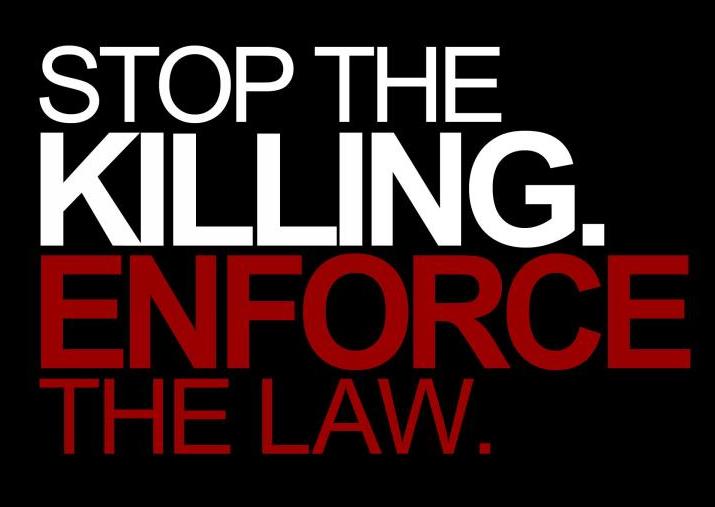 Sean McKenny, president of
the Ottawa & District Labour Council said the organization is
calling for criminal charges to be laid. "All those workers that were
working in the pit were
subjected to working in an unsafe environment," McKenny told media. Sean McKenny, president of
the Ottawa & District Labour Council said the organization is
calling for criminal charges to be laid. "All those workers that were
working in the pit were
subjected to working in an unsafe environment," McKenny told media.
The factors that led to this tragic death are no
mystery as in Ottawa it is an annual event that melting causes large
ice buildup to be dislodged. It is as regular as the seasons and plain
to see for all the workers. It was not a question of whether but when.
The private monopoly interests and governments that work for their
benefit are not blind but the life of a worker and
health and safety concerns are considered "costs" to be calculated and
disregarded as a block to making money.
After the death of Bruneau the Ministry of Labour
announced an investigation into the accident and issued orders to real
estate developer Claridge Homes to ensure the walls of the
excavation are clear of loose rock and submit a plan for review as to
how the ice buildup will be removed, as well as documentation on the
site plan and safety talks related to falling ice.
Bellai Brothers Construction Ltd. was ordered to provide documentation
on Bruneau's employment and follow various basic safety standards such
as ensuring ladders are on firm footing
and that equipment is used in accordance with manufacturers' operating
manuals.
TML Daily notes that the Ministry has used the
death of a worker as the starting point for demanding basic compliance
with legal standards. However it did not even issue an
order requiring that all ice be cleared from the pit walls before work
resume or for the site to be shut down immediately until
all safety requirements pass inspection, and that all
workers be compensated for lost time and be protected from
reprisal. Furthermore, charges should be laid against the developers
and construction companies involved and the
Bruneau family must be fully compensated.
Death and Injury in Crane Accident in Montreal
On April 10 one worker was killed and another seriously
injured while washing windows five storeys up on the Paul-Gerin-Lajoie
pavilion of the Universite du Quebec a Montreal at
Rene-Levesque Blvd. The injured worker remained in a critical state for
a number of days but luckily his condition has improved to stable.
The two workers fell more than 50 feet when the crane
holding the cage in which they were working overturned because the
truck on which it was mounted suddenly tilted. Other
workers washing windows on the site were in a state of shock and had to
be taken to the hospital as well. The man who died was the father of
the worker who was injured.
An investigation has since revealed that the crane
operator did not secure the truck properly on solid ground and as a
result the truck leaned over under the weight of the crane. Also
known now is that the crane operator had no formal training in the
standard operation of a crane. In Quebec, the training of crane
operators working on non-construction sites is not
mandatory. Non-construction crane operation is officially considered
less hazardous and it is left to private interests to decide the
qualifications of the operators. There are currently moves
to make crane operation non-mandatory on construction sites as well.

Workers Speak Out to Defend their Rights
On the occasion of the April 28 Day of Mourning TML
Daily is publishing statements from workers in steel,
construction, the railways, forestry, the public service and
representatives of injured workers' and migrant workers' organizations
discussing the problems in their sectors and how they are working to
defend health and safety. They show the
all-sided attacks taking place against the rights of workers and the
challenges workers are taking up to turn things around.
Mike Da Prat, President, United Steelworkers Local
2251,
Essar Steel Algoma
This company has gone from hazard identification-based
safety to behaviour-based safety. In other words, they are quick to
discipline. We have strong language and very good terms
of reference for the joint health and safety committee but the actions
of the company and the actions of the government have destroyed our
internal health and safety system, to the point
that I had to send the health and safety representatives back to work
because there were reprisals against them.
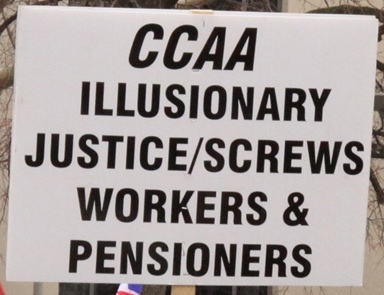 Then when we went under
bankruptcy protection under the Companies' Creditors Arrangement
Act (CCAA), I did not have the ability to file grievances because
they are all
stayed under the bankruptcy protection procedures. The company is
taking advantage of the CCAA but the CCAA did not change their
attitude. We were in full-fledged war with them
before the CCAA. What they want to do is create a whole new health and
safety committee even though ours is described in detail. Instead of
the health and safety reps getting their
directions and reporting to the union chairman they want them to report
to managers. Then when we went under
bankruptcy protection under the Companies' Creditors Arrangement
Act (CCAA), I did not have the ability to file grievances because
they are all
stayed under the bankruptcy protection procedures. The company is
taking advantage of the CCAA but the CCAA did not change their
attitude. We were in full-fledged war with them
before the CCAA. What they want to do is create a whole new health and
safety committee even though ours is described in detail. Instead of
the health and safety reps getting their
directions and reporting to the union chairman they want them to report
to managers.
Meanwhile, we have asbestos issues, we have the
conveyor lines that bring the coke way up to the top of the blast
furnace that are in a bad shape, our record keeping is in shambles
and yet they go around saying that we are doing great. They are
under-reporting. They discovered that the Ontario government does not
have the guts to enforce the law.
These multinationals are coming in, they push against
the laws, and if the law pushes back then they know they have reached
the limit. They are just trying whatever they want to do.
They have got lawyers on just in case, and then they find out they
don't need the lawyers because the responsible people in the Ministry
don't do anything. I blame the Wynne government
for that. The multinationals are challenging the laws the way the local
companies would never do. The law is not pushing back.
It is like we have to start this fight all over again.
Simon Lévesque, Director of Health and Safety,
FTQ-Construction
 The main problem we have is
that, more and more, the employers abdicate their responsibilities
regarding the health and safety of the workers and are putting the onus
on the workers
themselves. Article 51 of the Quebec Act respecting occupational
health and safety clearly says that the responsibility rests with
the employers. They have been trying to remove this
article for a long time and every day they blame the workers for the
deaths and injuries that happen at work. We keep saying No!, the
companies have to do what it takes to protect
workers. They are the ones who have the means to protect us. The main problem we have is
that, more and more, the employers abdicate their responsibilities
regarding the health and safety of the workers and are putting the onus
on the workers
themselves. Article 51 of the Quebec Act respecting occupational
health and safety clearly says that the responsibility rests with
the employers. They have been trying to remove this
article for a long time and every day they blame the workers for the
deaths and injuries that happen at work. We keep saying No!, the
companies have to do what it takes to protect
workers. They are the ones who have the means to protect us.
The daily pressure on the construction sites is to put
the onus on workers. We have had to intervene in cases such as on
buildings several storeys high where there were no guardrails
to prevent workers or material from falling. According to the
companies, the only issue safety-wise is that workers must wear a
safety harness that is tied to an anchor point. That is
basically it. To wear a safety harness does not protect workers from
falling. For the companies, this is also a matter of using repression:
"If you are not tied, you are out!"
Job security does not exist in the construction sector.
If a worker refuses to do the job because it is unsafe he is told that
other workers are available who will be willing to do the job.
The worker can raise issues, or representatives of the health and
safety compensation board can come on site and demand that changes be
made, but suddenly when Friday comes, the
worker is not needed anymore and is told not to come back the next
week. This amounts to firing. Employers want workers who are in top
shape and very productive and the load that is
put on them is greater every day, including looking after their own
health and safety. Disciplining is on the rise -- not gradual
disciplining, but immediate firing to make an example for
others. When construction slows down, as is the case in Quebec right
now, there is more pressure on workers and the injuries are more severe.
One of our main demands is to have unionized safety
representatives on the sites. On some of the biggest construction
sites, we have been able to negotiate to get safety representatives
who are doing only that -- going on the construction sites, denouncing
hazards, talking to workers, creating awareness, not using threats
against workers. We have won this even if the
sections of the health and safety Act that concern construction and
prescribe that there be safety representatives have never been
promulgated, and the Act was passed in 1979!
Doug Finnson, President, Teamsters Canada Rail
Conference
Our main problem is worker fatigue. We keep on being
asked to validate our concerns. "Show us the data," we are told. The
data has been there for 40 years. Among other things, the
data is in the 1990s when we had the CANALERT study and recommendations
in Calgary. The data is in the Railway Safety Act Review and
the published documents from
Transport Canada. I don't understand why workers have to keep on
demonstrating that there is fatigue in the railways when report after
report confirms there is fatigue in the railways. For
our opponents and the government, it is as if every year again and
again the workers cannot prove that there is fatigue, then somehow our
concerns are invalid.
 Worker fatigue is different
in different locations. At CP worker fatigue is worse. It is worse than
it was ever before because of the changes that CP management has made
in how they
treat workers, how they harass the workers and how they violate the
collective agreement and force workers into dangerous situations. At
CN, it is different, because our conductors have
been able to negotiate fatigue management plan where they schedule time
pools along the recommendations of CANALERT from the 1990s. Worker fatigue is different
in different locations. At CP worker fatigue is worse. It is worse than
it was ever before because of the changes that CP management has made
in how they
treat workers, how they harass the workers and how they violate the
collective agreement and force workers into dangerous situations. At
CN, it is different, because our conductors have
been able to negotiate fatigue management plan where they schedule time
pools along the recommendations of CANALERT from the 1990s.
At CN we have a negotiated agreement that is being
implemented across the country. At CP, we had time pools in Calgary. CP
cancelled them all, destroyed them all. We were able to
go to arbitration and regain back the fatigue management plan time pool
for the engineers but we were not successful for the conductors. So
half of our Calgary workers have it and the
other half don't have it. Time pools refer to a fixed window of time,
either morning, afternoon or night, when workers can be called for
duty. If they are not called within that window then
they are not to be called until the next day. It is a lot like shift
work. Within this, we are able to build in fatigue counter-measures at
away-from-home terminals.
We want to have a comprehensive scientific background
to our system and that is what CANALERT provided in the 1990s. We have
been fighting for that for the last 10 years. We
have been on strike twice in 2012 and 2015 and each time in large part
it was for fatigue issues. CP says that they want to change the ways we
are paid and then we will get more sleep. If
we pay you less money and make you work more often, they say, you will
be safer. We got the CEO of CP on record, we have a recording where he
says he wants Canadian railroaders to
work 60 hours a week with no overtime. That is what he wants.
CP is lobbying the government to change the law so that
it favours CP. We are fighting for the workers, we want the government
to say No!, the regulation should be consistent with
fatigue science and with CANALERT and the studies we already have.
We've got the studies. CP says that they are trying to give us rest,
that we are not booking maximum rest. The truth
is that when our guys book maximum rest, CP charges them before the
Labour Board for work stoppage. This is the issue we are facing.
Bob Kingston, Co-Chair, Public Service
Mental Health Joint Task Force
Psychological health and safety is probably at the top
of our concerns at the moment as far as the health and safety of the
workers is concerned. We have got the tools, we have to get
people trained. The biggest obstacle would be training. I am
co-chairing the Joint Task Force between the Treasury Board of Canada
and the Public Service Alliance of Canada on mental
health in the workplace. The largest number of absences from the
workplace is related to some kind of issue around psychological health
and safety, whether it is stress, burnout or mental
illness. These problems are not being dealt with properly. We have got
employers across the country denying that it is even part of the health
and safety scope of things. They are trying to
say that mental health is not a workplace issue when it is and there
are so many things that go on in the workplace and burn people out.
 The failure to properly
accommodate people when they need it burns people out. The failure to
properly get people back in the workplace if they have been off burns
people out.
There are so many workplace practices that have a negative impact on
the psychological health and safety of the workplace that they need to
be fixed. It is about how you treat people. You
can put together the best programs in the world, but if you are still
treating people like crap, you are still going to burn them out. The
training is going to be very important because what
we are trying to do is to humanize the workplaces and get them thinking
more about how they treat each other than how many files they can
close. We are trying to get management and
people in general to be willing to talk about it more openly and to put
it on the table as a health and safety issue with the health and safety
committee. The failure to properly
accommodate people when they need it burns people out. The failure to
properly get people back in the workplace if they have been off burns
people out.
There are so many workplace practices that have a negative impact on
the psychological health and safety of the workplace that they need to
be fixed. It is about how you treat people. You
can put together the best programs in the world, but if you are still
treating people like crap, you are still going to burn them out. The
training is going to be very important because what
we are trying to do is to humanize the workplaces and get them thinking
more about how they treat each other than how many files they can
close. We are trying to get management and
people in general to be willing to talk about it more openly and to put
it on the table as a health and safety issue with the health and safety
committee.
We help people understand that you can analyse it and
come up with preventive measures to deal with it just like you do it
with any other hazards. We want to take a close look at
what the causes are and what irritants are in the workplace and come up
with recommendations to fix those. In term of the working conditions,
to do more with less as a constant desire to
do nothing else than increase productivity and everything else be
damned, yes it is causing mental problems.
It is all about more and more with less and less, and
people are definitely feeling the squeeze. It is all about how many
phone calls you get through, you are put in stalls, you are
monitored, it is not about what good you to do to these people you are
helping, it is all about how many of them you can process. It all has a
huge effect on people's mental health.
Monique Déry, Health and Safety Committee
President,
Public Service Alliance of Canada (Quebec)
A major problem in Quebec is the fact that the Act
respecting occupational health and safety does not apply to all
the workers the same way. For example, we have more than
20,000 members in the university sector and they are not covered by the
full content of the Act because they do not belong to what is called a
"priority sector." We are asking that the law
be changed so that student-workers who are already facing non-standard
work schedules besides studying be covered by the full content of the
law. In Quebec, more than 80 per cent of the
workers are not fully covered by the law [The Act has four major safety
components that not all workers can access, depending on the sector
they work in: the joint health and safety
committee; the safety representative; the prevention program; and the
health program – TML Ed. Note].
PSAC-Quebec also represents more than 20,000 federal
public service workers. One of the major problems is all the cutbacks
that were done in federal public servants' positions
including the cutbacks in the inspector staffing levels. We are short
of people, short of inspectors in transportation, in the food sector,
everywhere. When workers retire, they are not getting
replaced, and a worker has to do the job of this worker besides his or
her own.
We are demanding that the federal government repeal the
changes that were done in the system, reinvest in the federal public
sector and bring the services to at least the level they
were at years ago so that the well being of the people is looked after.
Our people are exhausted and have to take long leaves of absence
because they are sick. All this also has a negative
impact on the public.
Peter Page, Coordinator, Justice for Injured Workers
Newspaper
There are a number of things that need to be addressed.
The fact that the Ontario government is claiming that to ensure the
sustainability of the compensation system, they need to
address the unfunded liability. If the sustainability of the system is
in such a crisis that they need to gather all this money to deal with,
why then are they giving assessment rates cuts to
employers, to the tune of $2 billion a year. Assessment rates are what
the employers have to pay, this is their insurance premium if you want.
Why giving money back to the employers
while they give nothing to the injured workers? Who is the system for?
Not to mention the money the employers get through experience rating,
when they get rebates that are based not on
their actual safety record but on their total claims costs.
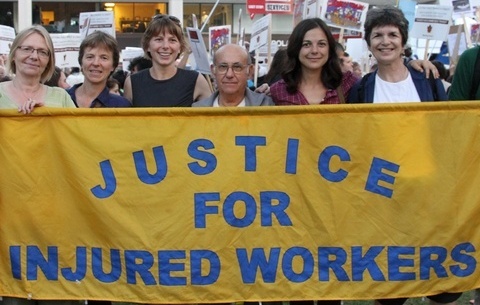 The Wynne government, the
WSIB are doing it again on the backs of the injured workers. It is the
injured workers that are paying for the unfunded liability. Who is
injured here: the
worker of the employer? They are cutting assessment rates by over 40
per cent. They took that money off the backs of the injured workers
through cutting their benefits, things like
preexisting conditions, just denying the workers' claims in any means
and ways they could. This is the thing that affects everything else. The Wynne government, the
WSIB are doing it again on the backs of the injured workers. It is the
injured workers that are paying for the unfunded liability. Who is
injured here: the
worker of the employer? They are cutting assessment rates by over 40
per cent. They took that money off the backs of the injured workers
through cutting their benefits, things like
preexisting conditions, just denying the workers' claims in any means
and ways they could. This is the thing that affects everything else.
Also there is the doctors' issue. The Board is saying
that they are going to make the decision on whether this worker is well
enough, not the treating physician, not the family doctor.
Doctors feel that their opinions are not being valued by the Board and
the Board is contracting out to other doctors to get them the reports
they want. These Board doctors are making
decisions on a paper review, they are not actually seeing the worker.
Most of the time, their recommendations are against what the treating
physician has ordered.
Chris Ramsaroop, Spokesperson, Justicia For Migrant
Workers
Migrant workers work under extremely exploitative
conditions. Their vulnerability is a result of restrictive federal
immigration laws that tie migrant workers to their employer and
weak provincial labour regimes that deny migrant workers basic rights
while working in Canada. Within the workplace migrant workers are
subjected to pesticide and chemical exposure,
long hours of repetitive tasks undertaken at an extremely fast pace.
Farm workers have consistently complained about piece rate, and the
impact that it has on their health and well being.
Piece rate is a system that pays a worker by the crop. Payment under
the piece rate is often arbitrary of what employers determine the rate
to be which creates uncertainty of what workers
will actually make. Often migrant workers once injured or sick are
returned to their home country without receiving proper compensation
under our WSIB system or adequate health
care.
Migrant farm workers are at a heightened risk of injury
and death as a result of their indentured employment in Canada. It's
time that both levels of government are forced to take a
stand to protect their rights and end the exploitation. As workers we
must show solidarity with injured migrant workers to end the apartheid
conditions they endure while in Canada and
provide migrants permanent residency status to end the employers'
control over their labour.
Ben Corpuz, Filipino Workers' Network
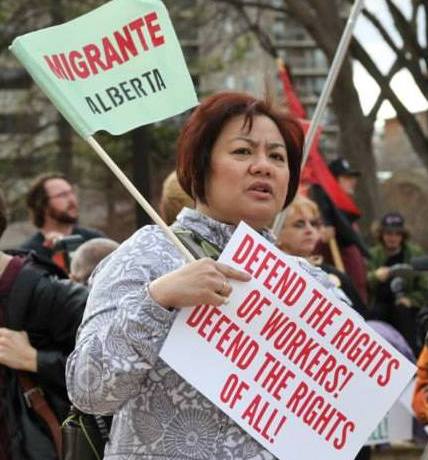 Five to six thousand workers
are forced to leave the Philippines every day to find work to provide
for their families. Almost 20 per cent of these workers come to Canada
and half of
that number come to Ontario to work in the hotel and food industry, as
live-in-care givers in private homes, senior's residences and other
types of what we call precarious work. Canada is
the single largest destination of migrant or temporary workers from the
Philippines. These workers are subject to long working hours, few
benefits, no over-time pay and are not protected
by the Labour Standards Act or have legal recourse when their
rights are violated. If they complain about anything they are sent back
to the Philippines. Five to six thousand workers
are forced to leave the Philippines every day to find work to provide
for their families. Almost 20 per cent of these workers come to Canada
and half of
that number come to Ontario to work in the hotel and food industry, as
live-in-care givers in private homes, senior's residences and other
types of what we call precarious work. Canada is
the single largest destination of migrant or temporary workers from the
Philippines. These workers are subject to long working hours, few
benefits, no over-time pay and are not protected
by the Labour Standards Act or have legal recourse when their
rights are violated. If they complain about anything they are sent back
to the Philippines.
This means that there is a high incidence of health and
safety problems that Filipino migrant and temporary workers face every
day. They are often abused by their employers because
they are so vulnerable. There have even been cases of workers being
killed on the job such as live-in-caregiver Marites Angan who died in
2014 after falling down and suffering a head
injury in her employer's garage. No one knows the circumstances of her
death. Who is going to look after the 14-year-old son she left behind?
We are demanding that all migrant workers and live-in
care-givers receive permanent status when they arrive in Canada. If
their work is needed by Canada, then they should be treated
like human beings and have their rights as workers upheld including
their right to decent wages and working conditions with proper health
and safety protections. These are basic human
rights.
Sucha Deepak, Stand Up for the North, Prince George, BC
As governments and their agencies abdicate their social
responsibility, enforce monopoly right over public right and let the
monopolies off scot free, the necessity to sort out the
problem of how to hold them to account becomes increasingly urgent.
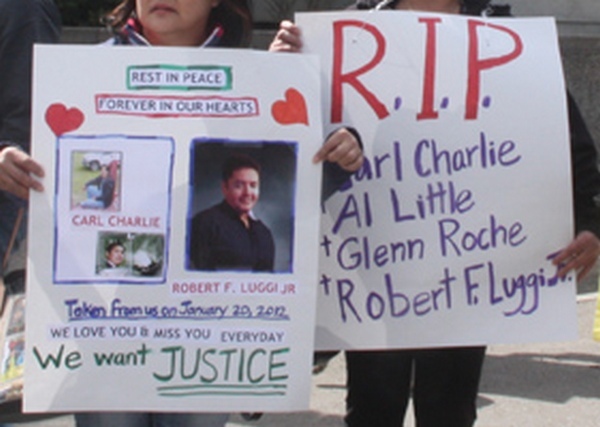 This will be on the minds
of workers and their families in the forestry communities in Northern
British Columbia on April 28. For more than three years forestry
workers,
communities and indigenous peoples in BC have been demanding an
independent inquiry into the fires and explosions that destroyed the
Babine and Lakeland sawmills in 2012 killing four
workers and injuring 44. The workers, communities and families have
been left with lasting scars and great indignation towards those who
refuse to see justice done. This will be on the minds
of workers and their families in the forestry communities in Northern
British Columbia on April 28. For more than three years forestry
workers,
communities and indigenous peoples in BC have been demanding an
independent inquiry into the fires and explosions that destroyed the
Babine and Lakeland sawmills in 2012 killing four
workers and injuring 44. The workers, communities and families have
been left with lasting scars and great indignation towards those who
refuse to see justice done.
WorkSafeBC declared the accident preventable, but as of
today no one has been charged with criminal negligence for the killing
and no legally-binding recommendation has been made
to make such workplaces safer.
In these communities and elsewhere in Canada,
collectives of workers are fighting to hold the companies, governments
and agencies tasked with upholding health and safety standards
accountable for their negligence so that these tragedies and crimes do
not happen again.

PREVIOUS
ISSUES | HOME
Read The Marxist-Leninist
Daily
Website: www.cpcml.ca
Email: editor@cpcml.ca
|


















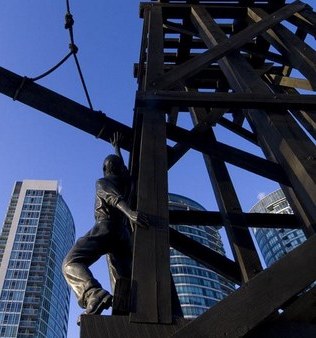









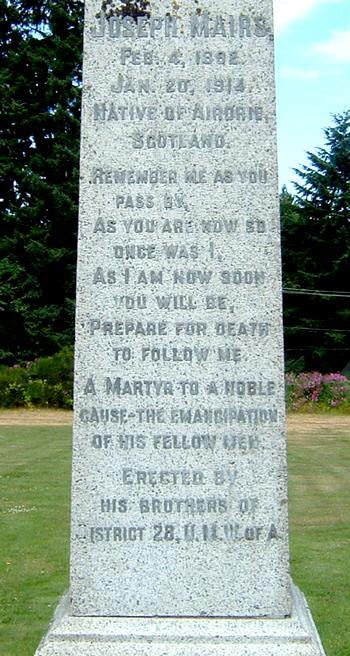
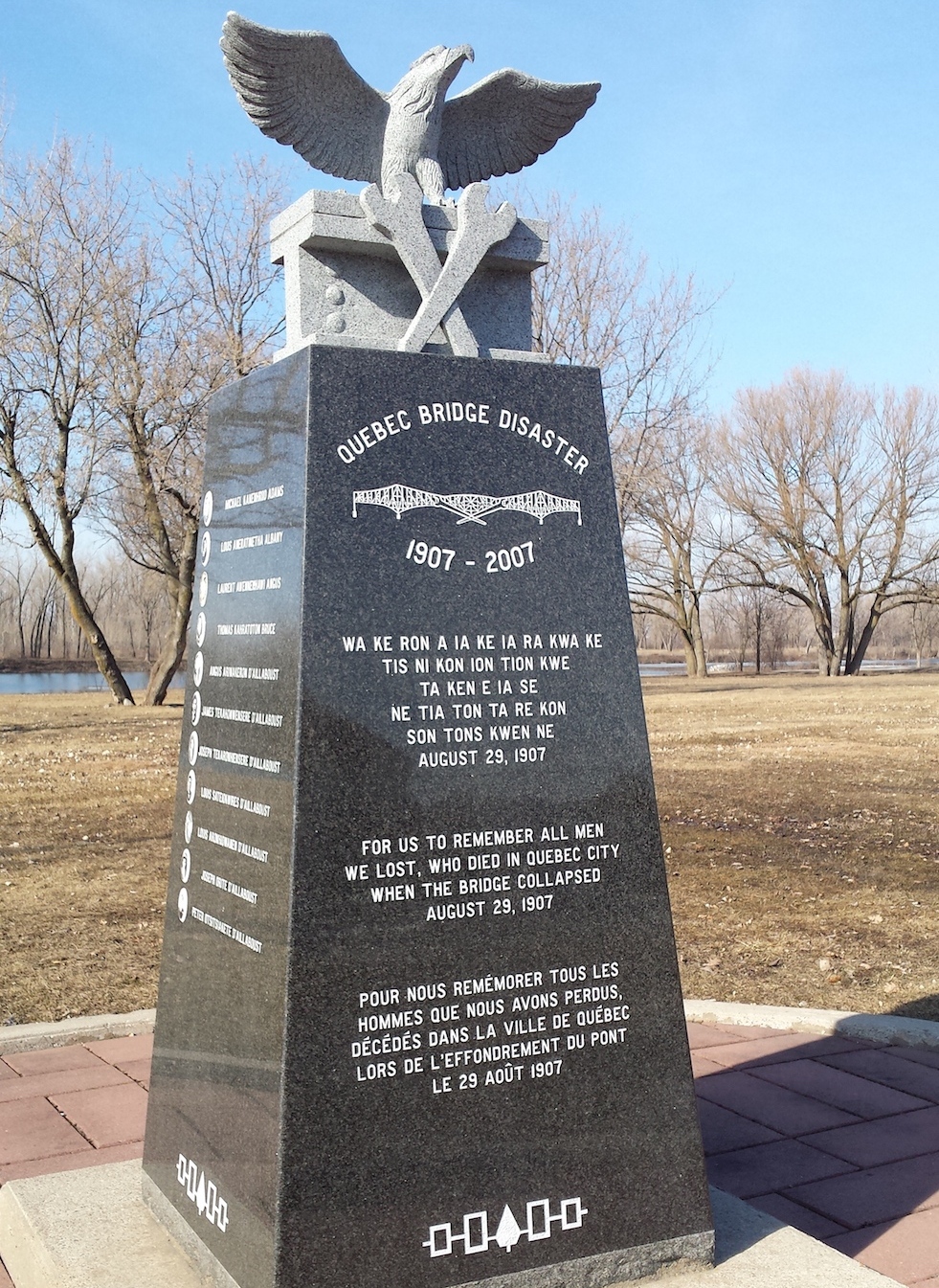

 On April 28, workers boldly
declare that all workers must be protected according to the highest
standards possible in all conditions and circumstances. They reject the
ideological and
institutional schemes being put forward to deny their demand for safe
and healthy working conditions for all as a matter of right.
On April 28, workers boldly
declare that all workers must be protected according to the highest
standards possible in all conditions and circumstances. They reject the
ideological and
institutional schemes being put forward to deny their demand for safe
and healthy working conditions for all as a matter of right. The aim of this fight is to
turn things around and bring about a change in the lives of workers,
their families, communities and the country based on solving problems
posed by
production and how human beings relate to one another to give people
control over their lives. This is how workers' health and safety can be
defended and guaranteed. The feeling of
powerlessness that is imposed on the workers by the arrogant refusal of
the monopolies, governments and agencies to be held to account must be
ended once and for all.
The aim of this fight is to
turn things around and bring about a change in the lives of workers,
their families, communities and the country based on solving problems
posed by
production and how human beings relate to one another to give people
control over their lives. This is how workers' health and safety can be
defended and guaranteed. The feeling of
powerlessness that is imposed on the workers by the arrogant refusal of
the monopolies, governments and agencies to be held to account must be
ended once and for all.
 The Toronto Airport
Workers' Council reported that the past 12 months "have been hard on
our airport community with some very high profile injuries and now
horrific deaths."
Another worker died in March of a medical condition while working on
the ramp, the Council reported. An 18-year-old ramp worker was
critically injured in September, 2015 in a collision
between a baggage vehicle and another vehicle.
The Toronto Airport
Workers' Council reported that the past 12 months "have been hard on
our airport community with some very high profile injuries and now
horrific deaths."
Another worker died in March of a medical condition while working on
the ramp, the Council reported. An 18-year-old ramp worker was
critically injured in September, 2015 in a collision
between a baggage vehicle and another vehicle. Sean McKenny, president of
the Ottawa & District Labour Council said the organization is
calling for criminal charges to be laid. "All those workers that were
working in the pit were
subjected to working in an unsafe environment," McKenny told media.
Sean McKenny, president of
the Ottawa & District Labour Council said the organization is
calling for criminal charges to be laid. "All those workers that were
working in the pit were
subjected to working in an unsafe environment," McKenny told media. The main problem we have is
that, more and more, the employers abdicate their responsibilities
regarding the health and safety of the workers and are putting the onus
on the workers
themselves. Article 51 of the Quebec Act respecting occupational
health and safety clearly says that the responsibility rests with
the employers. They have been trying to remove this
article for a long time and every day they blame the workers for the
deaths and injuries that happen at work. We keep saying No!, the
companies have to do what it takes to protect
workers. They are the ones who have the means to protect us.
The main problem we have is
that, more and more, the employers abdicate their responsibilities
regarding the health and safety of the workers and are putting the onus
on the workers
themselves. Article 51 of the Quebec Act respecting occupational
health and safety clearly says that the responsibility rests with
the employers. They have been trying to remove this
article for a long time and every day they blame the workers for the
deaths and injuries that happen at work. We keep saying No!, the
companies have to do what it takes to protect
workers. They are the ones who have the means to protect us.  Worker fatigue is different
in different locations. At CP worker fatigue is worse. It is worse than
it was ever before because of the changes that CP management has made
in how they
treat workers, how they harass the workers and how they violate the
collective agreement and force workers into dangerous situations. At
CN, it is different, because our conductors have
been able to negotiate fatigue management plan where they schedule time
pools along the recommendations of CANALERT from the 1990s.
Worker fatigue is different
in different locations. At CP worker fatigue is worse. It is worse than
it was ever before because of the changes that CP management has made
in how they
treat workers, how they harass the workers and how they violate the
collective agreement and force workers into dangerous situations. At
CN, it is different, because our conductors have
been able to negotiate fatigue management plan where they schedule time
pools along the recommendations of CANALERT from the 1990s. The failure to properly
accommodate people when they need it burns people out. The failure to
properly get people back in the workplace if they have been off burns
people out.
There are so many workplace practices that have a negative impact on
the psychological health and safety of the workplace that they need to
be fixed. It is about how you treat people. You
can put together the best programs in the world, but if you are still
treating people like crap, you are still going to burn them out. The
training is going to be very important because what
we are trying to do is to humanize the workplaces and get them thinking
more about how they treat each other than how many files they can
close. We are trying to get management and
people in general to be willing to talk about it more openly and to put
it on the table as a health and safety issue with the health and safety
committee.
The failure to properly
accommodate people when they need it burns people out. The failure to
properly get people back in the workplace if they have been off burns
people out.
There are so many workplace practices that have a negative impact on
the psychological health and safety of the workplace that they need to
be fixed. It is about how you treat people. You
can put together the best programs in the world, but if you are still
treating people like crap, you are still going to burn them out. The
training is going to be very important because what
we are trying to do is to humanize the workplaces and get them thinking
more about how they treat each other than how many files they can
close. We are trying to get management and
people in general to be willing to talk about it more openly and to put
it on the table as a health and safety issue with the health and safety
committee. The Wynne government, the
WSIB are doing it again on the backs of the injured workers. It is the
injured workers that are paying for the unfunded liability. Who is
injured here: the
worker of the employer? They are cutting assessment rates by over 40
per cent. They took that money off the backs of the injured workers
through cutting their benefits, things like
preexisting conditions, just denying the workers' claims in any means
and ways they could. This is the thing that affects everything else.
The Wynne government, the
WSIB are doing it again on the backs of the injured workers. It is the
injured workers that are paying for the unfunded liability. Who is
injured here: the
worker of the employer? They are cutting assessment rates by over 40
per cent. They took that money off the backs of the injured workers
through cutting their benefits, things like
preexisting conditions, just denying the workers' claims in any means
and ways they could. This is the thing that affects everything else. Five to six thousand workers
are forced to leave the Philippines every day to find work to provide
for their families. Almost 20 per cent of these workers come to Canada
and half of
that number come to Ontario to work in the hotel and food industry, as
live-in-care givers in private homes, senior's residences and other
types of what we call precarious work. Canada is
the single largest destination of migrant or temporary workers from the
Philippines. These workers are subject to long working hours, few
benefits, no over-time pay and are not protected
by the Labour Standards Act or have legal recourse when their
rights are violated. If they complain about anything they are sent back
to the Philippines.
Five to six thousand workers
are forced to leave the Philippines every day to find work to provide
for their families. Almost 20 per cent of these workers come to Canada
and half of
that number come to Ontario to work in the hotel and food industry, as
live-in-care givers in private homes, senior's residences and other
types of what we call precarious work. Canada is
the single largest destination of migrant or temporary workers from the
Philippines. These workers are subject to long working hours, few
benefits, no over-time pay and are not protected
by the Labour Standards Act or have legal recourse when their
rights are violated. If they complain about anything they are sent back
to the Philippines.  This will be on the minds
of workers and their families in the forestry communities in Northern
British Columbia on April 28. For more than three years forestry
workers,
communities and indigenous peoples in BC have been demanding an
independent inquiry into the fires and explosions that destroyed the
Babine and Lakeland sawmills in 2012 killing four
workers and injuring 44. The workers, communities and families have
been left with lasting scars and great indignation towards those who
refuse to see justice done.
This will be on the minds
of workers and their families in the forestry communities in Northern
British Columbia on April 28. For more than three years forestry
workers,
communities and indigenous peoples in BC have been demanding an
independent inquiry into the fires and explosions that destroyed the
Babine and Lakeland sawmills in 2012 killing four
workers and injuring 44. The workers, communities and families have
been left with lasting scars and great indignation towards those who
refuse to see justice done.